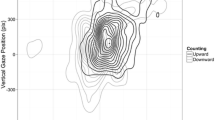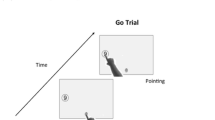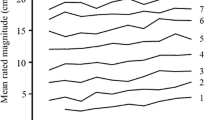Abstract
The cognitive representation of numbers has been studied with chronometric methods but these cannot resolve the current debate about the metrical structure of the “mental number line”. We recorded spatial behaviour as blindfolded adults described the locations of numbers (e.g., “where is 3?”) by pointing and the lengths of magnitudes (e.g., “how much is 56?”) by gesturing. Their unconstrained spatial behaviour revealed idiosyncratic spatial associations for numbers and largely supports a linear representation of magnitudes.


Similar content being viewed by others
References
Andres M, Ostry DJ, Nicol F, Paus T (2008) Time course of number magnitude interference during grasping. Cortex 44:414–419
Brannon EM, Wusthoff CJ, Gallistel CR, Gibbon J (2001) Numerical subtraction in the pigeon: evidence for a linear subjective number scale. Psychol Sci 12(3):238–246
Dehaene S (2003) The neural basis of the Weber-Fechner law: a logarithmic mental number line. Trends Cogn Sci 7(4):145–147
Dehaene S, Izard V, Spelke E, Pica P (2008) Log or linear? Distinct intuitions of the number scale in Western and Amazonian indigene cultures. Science 320:1217–1220
Galton F (1880) Visualized numerals. Nature 21:252–256
Hostetter AB, Alibali MW (2008) Visible embodiment: gestures as simulated action. Psychon Bull Rev 15(3):495–514
Moyer RS, Landauer TK (1967) Time required for judgments of numerical inequality. Nature 215:1519–1520
Nieder A, Friedman DJ, Miller EK (2003) Representation of the quantity of visual items in the prefrontal cortex. Science 297:1708–1711
Restle F (1970) Speed of adding and comparing numbers. J Exp Psychol 83:274–278
Rizzolatti G, Arbib MA (1998) Language within our grasp. Trends Neurosci 21(5):188–194
Siegler RS, Opfer JE (2003) The development of numerical estimation: evidence for multiple representations of numerical quantity. Psychol Sci 14(3):237–243
Verguts T, Fias W, Stevens M (2005) A model of exact small-number representation. Psychon Bull Rev 12(1):66–80
Whalen J, Gallistel CR, Gelman R (1999) Nonverbal counting in humans: the psychophysics of number representation. Psychol Sci 10(2):130–137
Wood G, Nuerk HC, Willmes K, Fischer MH (2008) On the cognitive link between space and number: a meta-analysis of the SNARC Effect. Psychol Sci Q (in press)
Zorzi M, Stoianov I, Umilta C (2005) Computational modeling of numerical cognition. In: Campbell J (ed) Handbook of mathematical cognition. Psychology Press, New York, pp 67–83
Acknowledgments
MHF is member of the Marie Curie Research and Training Network: Language and Brain (http://www.hull.ac.uk/RTN-LAB/) His work is funded by the European Commission (MRTN-CT-2004-512141 and 05_ECRP_FP006) as part of its Sixth Framework Program. H.C. was sponsored by an Erasmus student exchange scheme from the European Commission.
Author information
Authors and Affiliations
Corresponding author
Rights and permissions
About this article
Cite this article
Fischer, M.H., Campens, H. Pointing to numbers and grasping magnitudes. Exp Brain Res 192, 149–153 (2009). https://doi.org/10.1007/s00221-008-1622-3
Received:
Accepted:
Published:
Issue Date:
DOI: https://doi.org/10.1007/s00221-008-1622-3




